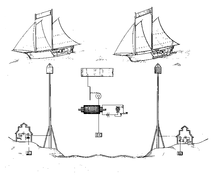Wireless communication theories and methods previous to radio
Before the discovery of electromagnetic waves and the development of radio communication, there were many wireless telegraph systems proposed and tested.[4] In April 1872 William Henry Ward received U.S. patent 126,356 for a wireless telegraphy system where he theorized that convection currents in the atmosphere could carry signals like a telegraph wire.[5] A few months after Ward received his patent, Mahlon Loomis of West Virginia received U.S. patent 129,971 for a similar "wireless telegraph" in July 1872.[6][7] The patented system claimed to utilize atmospheric electricity to eliminate the overhead wire used by the existing telegraph systems. It did not contain diagrams or specific methods and it did not refer to or incorporate any known scientific theory.
 Thomas Edison's 1891 patent for a ship-to-shore wireless telegraph that used electrostatic induction
Thomas Edison's 1891 patent for a ship-to-shore wireless telegraph that used electrostatic induction
In the United States, Thomas Edison, in the mid-1880s, patented an electromagnetic induction system he called "grasshopper telegraphy", which allowed telegraphic signals to jump the short distance between a running train and telegraph wires running parallel to the tracks.[8] In the United Kingdom, William Preece was able to develop an electromagnetic induction telegraph system that, with antenna wires many kilometers long, could transmit across gaps of about 5 kilometres (3.1 miles). Inventor Nathan Stubblefield, between 1885 and 1892,[9] also worked on an induction transmission system.
A form of wireless telephony is recorded in four patents for the photophone, invented jointly by Alexander Graham Bell and Charles Sumner Tainter in 1880. The photophone allowed for the transmission of sound on a beam of light, and on 3 June 1880, Bell and Tainter transmitted the world's first wireless telephone message on their newly invented form of light telecommunication.[10][11]
In the early 1890s Nikola Tesla began his research into high-frequency electricity. Tesla was aware of Hertz's experiments with electromagnetic waves from 1889 on[12][13] but, (like many scientists of that time) thought, even if radio waves existed, they would probably only travel in straight lines making them useless for long range transmission.[14]
Instead of using radio waves, Tesla's efforts were focused on building a conduction-based power distribution system,[15][16][14] although he noted in 1893 that his system could also incorporate communication. His laboratory work and later large-scale experiments at Colorado Springs led him to the conclusion that he could build a conduction-based worldwide wireless system that would use the Earth itself (via injecting very large amounts of an electric current into the ground) as the means to conduct the signal very long distances (across the Earth), overcoming the perceived limitations of other systems.[17] He went on to try to implement his ideas of power transmission and wireless telecommunication in his very large but unsuccessful Wardenclyffe Tower project.[18]